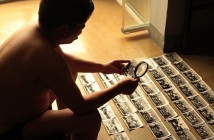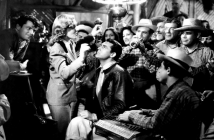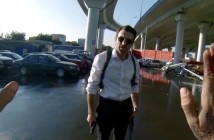Cast: Bruce Lee, Nora Miao, James Tien
Director: Wei Lo
Country: Hong Kong
Genre: Action | Drama | Romance
Official Trailer: Here
Editor’s Notes: The following review of Police Story is part of our coverage for TIFF’s A Century of Chinese Cinema which runs from June 5th to August 11th at TIFF Bell Lightbox. For more information of this unprecedented film series visit http://tiff.net/century and follow TIFF on Twitter at @TIFF_NET.
Golden Harvest kung fu flicks have always maintained a gritty competitive edge over most of the more elegant faire from Shaw Brothers Studios, but the ferocity of Bruce Lee gives Fist of Fury a primal quality not usually found in the genre as he unleashes his fury on every enemy in effortless atomic explosions of force. The plot is your standard kung fu revenge fare, but Lee undergoes no second act as he brutally forces his way through every enemy with ferocious ease, no lessons to learn in order to decipher and unlock an enemy’s illogical Achilles weakness; the only way that an enemy can even touch Lee’s Chen Zhen is through attrition. Fist of Fury is an explosive film that borrows elements from spaghetti westerns and tropes from within its own genre to construct a hybrid with an indestructible hero that rides into town and leaves a trail of destruction in his wake but with fists more lethal than six-shooters.
The plot is your standard kung fu revenge fare, but Lee undergoes no second act as he brutally forces his way through every enemy with ferocious ease, no lessons to learn in order to decipher and unlock an enemy’s illogical Achilles weakness; the only way that an enemy can even touch Lee’s Chen Zhen is through attrition.
 The choreography of Fist of Fury was arranged by Bruce Lee himself, and his small iron-like frame is suited to lightning-fast action as he uncoils his tremendous power onto his enemies with the speed and coldly calculated accuracy of a rattlesnake. He takes on large groups of opponents effortlessly, but without the grace and form one would find in a Shaw Brothers film directed by masters like Chang Cheh and Lau Kar Leung. The style of choreography used in their films was elegant, derived from the grand spectacle of Chinese opera. These operatic roots would lend the fight choreography of their films cinematic grace, not necessarily rooted in pragmatic martial arts techniques but wonderful to observe on the screen, but Lee’s quickdraw choreography owes more to the controlled bursts of Japanese samurai films and the cavalier self-assured invincibility of spaghetti western heroes. His punches pack the power of a Colt .45 revolver, but needs no reloading as he can dispatch seemingly endless opponents with the surefire accuracy of Clint Eastwood in a Sergio Leone film.
The choreography of Fist of Fury was arranged by Bruce Lee himself, and his small iron-like frame is suited to lightning-fast action as he uncoils his tremendous power onto his enemies with the speed and coldly calculated accuracy of a rattlesnake. He takes on large groups of opponents effortlessly, but without the grace and form one would find in a Shaw Brothers film directed by masters like Chang Cheh and Lau Kar Leung. The style of choreography used in their films was elegant, derived from the grand spectacle of Chinese opera. These operatic roots would lend the fight choreography of their films cinematic grace, not necessarily rooted in pragmatic martial arts techniques but wonderful to observe on the screen, but Lee’s quickdraw choreography owes more to the controlled bursts of Japanese samurai films and the cavalier self-assured invincibility of spaghetti western heroes. His punches pack the power of a Colt .45 revolver, but needs no reloading as he can dispatch seemingly endless opponents with the surefire accuracy of Clint Eastwood in a Sergio Leone film.
The spaghetti Western roots don’t end with Lee’s rapid-fire choreography as even the title sequence borrows heavily from Ennio Morricone’s legendary guitar soundtracks, replacing the immaculate staccatos of Morricone’s guitars with vocal arrangements but capturing the same ambling effect as its Italian counterparts. Zoom cuts to the eyes of characters mimic the camerawork of Leone’s westerns and create momentary respites of tension between Lee’s incendiary choreography. The hero of Fist of Fury rides into town in a rickshaw wearing all white, ready to avenge his fallen master and protect the “townsfolk” from the unfair clutches of their evil Japanese oppressors.
It cares little for historical accuracy or world relations as it simply uses them as plot elements that would have easily exploited the emotions of a Chinese audience at the time of its release.
 Like many kung fu films of its time, the tension between Japan and China take center stage as the Japanese are portrayed as evil mustached villains and overweight buffoons. Lau Kar Leung would tackle this divide with mutual respect for martial arts techniques from both countries in his 1978 Shaw Brothers film Heroes of the East, but Fist of Fury is more exploitative in its portrayal of the Japanese, though superior to the students of Lee’s school, Lee himself can dispatch them with tense casual ease. It cares little for historical accuracy or world relations as it simply uses them as plot elements that would have easily exploited the emotions of a Chinese audience at the time of its release. There are no explorations of technique or contrast of form between the styles of two different cultures because Fist of Fury is simply pure exploitative entertainment. The only exhibitions of technique come from a Russian expatriate, and those are merely stagey contrivances to show his strength which proves mostly ineffectual against Lee’s superior speed and cunning.
Like many kung fu films of its time, the tension between Japan and China take center stage as the Japanese are portrayed as evil mustached villains and overweight buffoons. Lau Kar Leung would tackle this divide with mutual respect for martial arts techniques from both countries in his 1978 Shaw Brothers film Heroes of the East, but Fist of Fury is more exploitative in its portrayal of the Japanese, though superior to the students of Lee’s school, Lee himself can dispatch them with tense casual ease. It cares little for historical accuracy or world relations as it simply uses them as plot elements that would have easily exploited the emotions of a Chinese audience at the time of its release. There are no explorations of technique or contrast of form between the styles of two different cultures because Fist of Fury is simply pure exploitative entertainment. The only exhibitions of technique come from a Russian expatriate, and those are merely stagey contrivances to show his strength which proves mostly ineffectual against Lee’s superior speed and cunning.
While Fist of Fury doesn’t carry much in the way of new ideas it is entertaining and though not as exquisitely crafted as some of its Shaw counterparts it uses more exploitative methods to entertain, elements borrowed from the tried and true history of exploitation cinema. Its camerawork is astute and some of its indoor settings carry a baroque cinematic quality, while outdoor scenes find themselves largely in angular corridors of concrete and shadow between its explosive action sequences. Bruce Lee is at his unfettered best as he unleashes his titular “fist of fury” with unmitigated and dangerous indignation, untouchable through his speed and relentless ferocity.
[notification type=”star”]70/100 ~ GOOD. While Fist of Fury doesn’t carry much in the way of new ideas it is entertaining and though not as exquisitely crafted as some of its Shaw counterparts it uses more exploitative methods to entertain, elements borrowed from the tried and true history of exploitation cinema. Its camerawork is astute and some of its indoor settings carry a baroque cinematic quality, while outdoor scenes find themselves largely in angular corridors of concrete and shadow between its explosive action sequences.[/notification]



